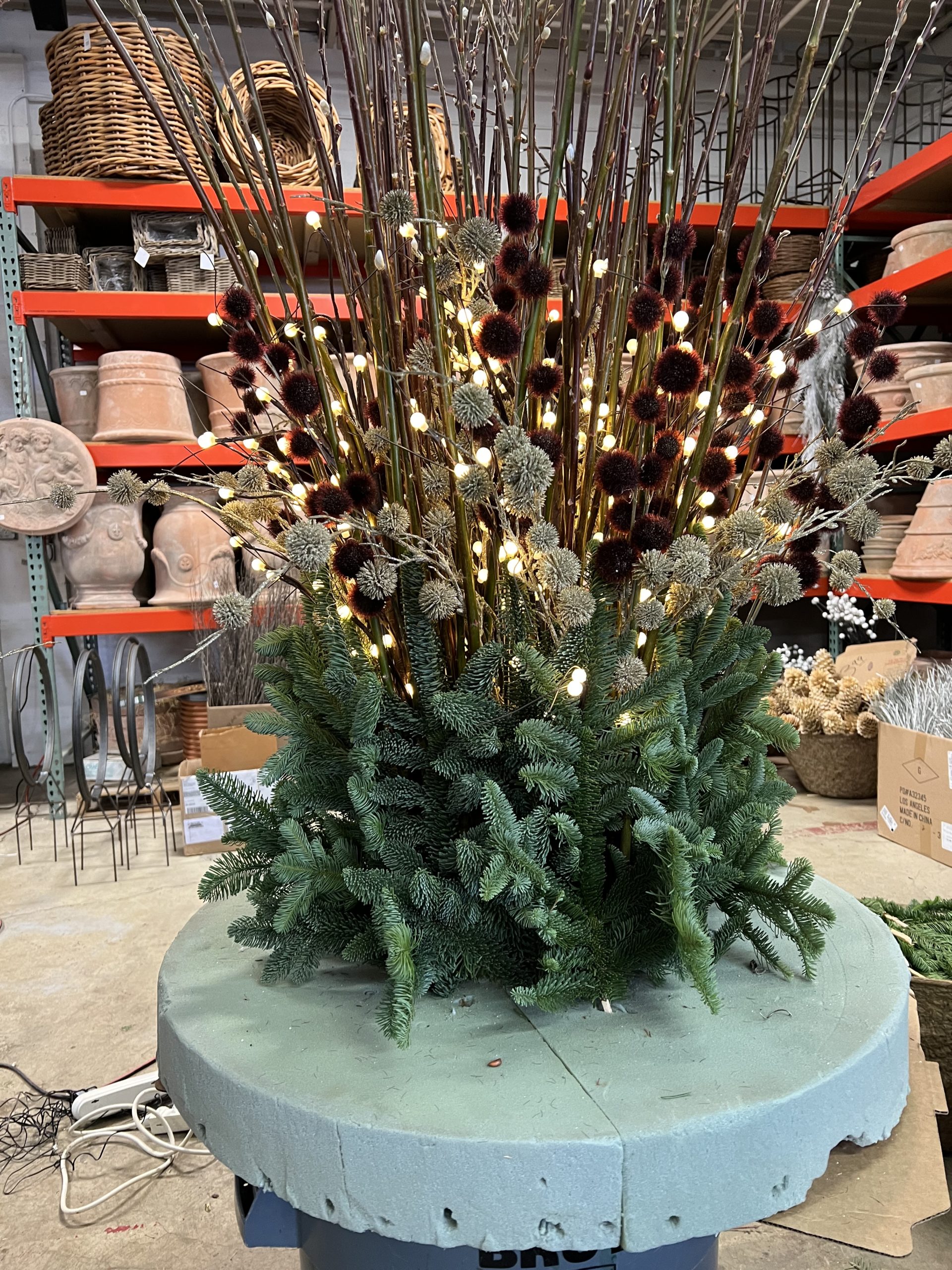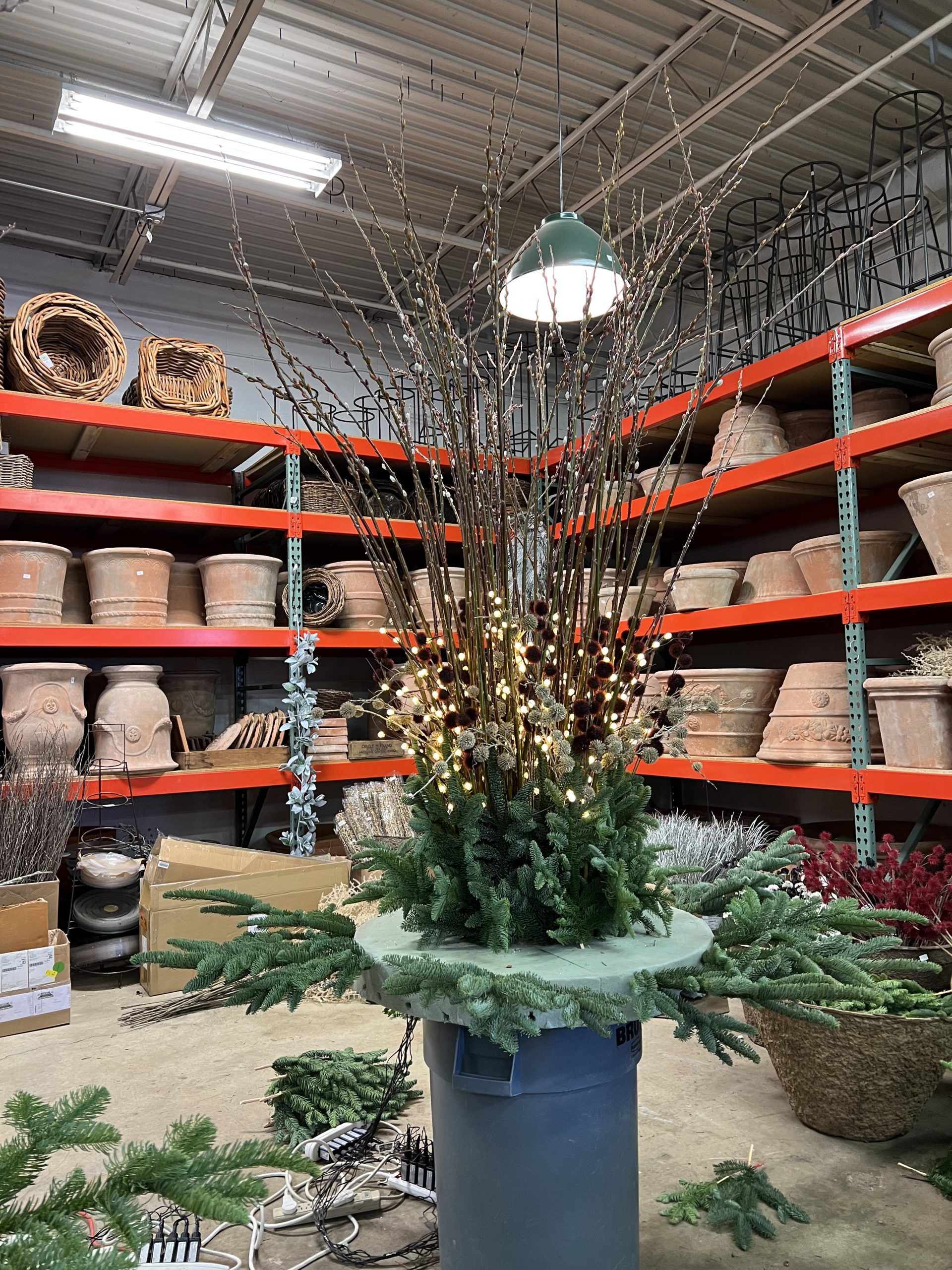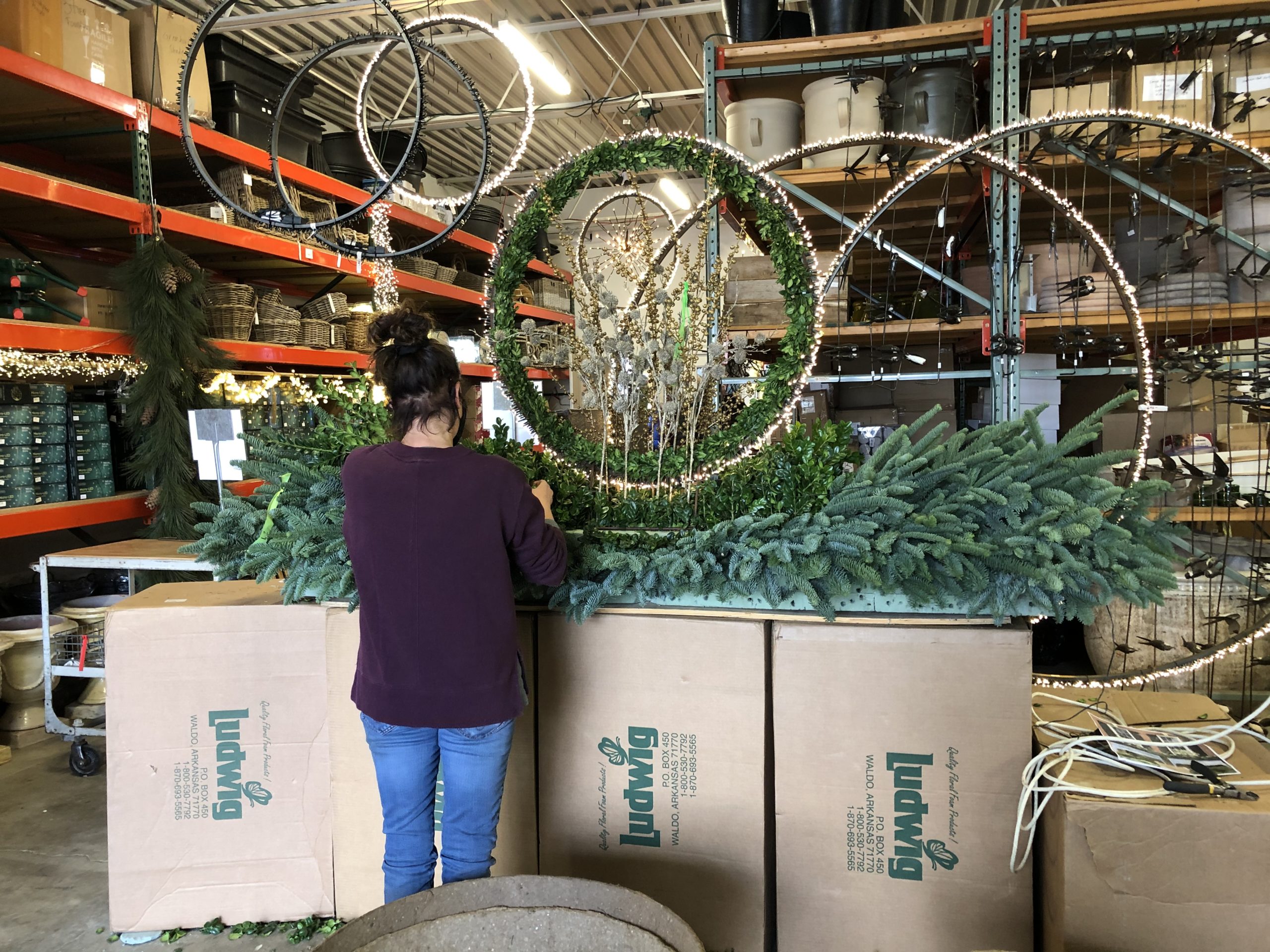
I recently ran across some pictures of holiday containers from the year 2000. The year 2000? I was faint with surprise. It is impossible to believe that we have just finished our 21st season designing, fabricating and installing winter arrangements in pots and containers, but indeed we have. I would have guessed we had 10 years into it, at most. It seems those decades flew by. How is it possible to have sustained a keen interest in the work for that many years, much less kept it fresh and innovative?

Of course one’s approach to the work evolves with experience. In the early days we installed all of the materials in containers on site, in very cold and otherwise inhospitable conditions. All of the materials were inserted into the soil. It took a few years to rewrite that protocol, but now all of the work is done indoors, in custom made forms that are saved and reused from year to year. If you read here regularly, you have heard all about this before. We have a broker of excellent repute and outstanding service supply us with evergreen boughs of incredible size and heft. The picture above and below tell the story of those greens. The dry, preserved and faux materials we are able to add to our arrangements have become more sophisticated and more wide ranging over the years. The materials themselves suggest and inform the design. Great materials enable great work – so all my best to you, and thank you, Rob. But what the 21 years we have in to designing and fabricating the winter pots got me to thinking about has to do with aesthetics. The art and sculpture of it, if you will.

In the beginning we had our mandate – even though we may not have been so conscious of it. Being gardeners, the most beautiful arrangements of greens would of course be those arrangements that most closely replicated the natural arrangement of greens in living and growing evergreen trees and shrubs. Those arrangements engineered by nature have evolved to maximize the health and well being of the plant, and future generations of that plant. Our goal was to arrange cut greens to look as though they were part of a live tree, and growing. We would try to copy nature in exacting detail. There are winter containers we have done that appear to have evergreen shrubs growing in them. We’ve been asked about how to water them more than just a few times. Clients would admire that we were able to make our winter containers look real. Though nature’s works are extraordinarily sculptural, they are after all, nature’s works, and not ours. How would we improve on what nature had already done? We wouldn’t. But we could interpret, celebrate and document our relationship with nature in any number of ways.

Considering the possibility of arranging greens in a not necessarily natural way was uncharted territory. We needed to go in that direction, but that process was like sailing a sailboat directly in to the wind. A sailboat is able to make forward progress into a headwind by a process called tacking. The boat is moved across the wind by turning the bow towards and through the wind in one direction, and then back across the wind in the other. This zig zag movement, if it is skillfully done, has a strong vertical component. It produces forward motion towards a desired destination. If the turning into the wind is of a slight and subtle angle, rather than a sharp 90 degree turn, it produces a phenomena known as sailing close to the wind. Meaning a very small change can make forward progress possible. To anyone reading who truly is a sailor, I apologize for this shallow discussion of tacking. But even a oversimplified version of it helps to explain how our work has evolved creatively.

What are our headwinds? Being reluctant to entertain change is the strongest. Sometimes a lack of imagination or a loss of interest can whip up a stiff headwind. The arrangement pictured above was notable for us, as we deliberately inserted the evergreen boughs adjacent to the centerpiece in a vertical position. It was the first time in at least 15 years – taking that tack. The very first picture in this post illustrates that clearly. The moment we were able to set branches at a horizontal angle in a rigid foam armature, we abandoned ever setting branches vertically again. We were free from the demands imposed by constructing arrangements in the soil. But one set of freedom enabled another kind of prison-not assessing each project on the merits. We made this small incrementally small change in our construction protocol for this pot ostensibly to conceal the faux stems of our faux picks. But the consequences of this small change-the impulse to go vertical in this pot – proved to be substantial. The overall shape was very different-gorgeous to my eye. Natasha did an incredible job setting the greens in this pot. Stunning. Her attention to detail and understanding of mass, volume and shape is obvious.

The following photographs detail the construction of winter arrangements for a set of window boxes that we did last year. It is clear from the pictures that the greens have been set at angles that respond to the geometry of the light ring in the center. The light ring was lined with a heavy weight boxwood garland, that visually connects to the shaped boxwood that follows the radius of the bottom of the light ring. How the boxwood is installed makes the light ring look integral to the arrangement-in a sculptural way. Boxwood would not grow like this, but it might live like this were it trimmed. That would endow the boxwood with the evidence of the human hand. Noble fir branches would not grow like this either. It is clear that this arrangement is of a different sort. And it is definitely not a representation of a noble fir tree.

There are those who might say that the evidence of the human hand is greatly inferior to the hand of nature. I don’t subscribe to that notion, as I do not see the two forces as comparable. They are relatable, integral to one another, but different. Equally interesting. Equally essential.

This picture taken in the shop after the construction was finished illustrates to my mind how a winter arrangement can be sculptural. It took a while to convince Birdie that it would be good and beautiful to install the long greens with an upward trajectory. Like angel wings. What an incredibly beautiful job she did. Ten minutes in, she knew exactly where she was going. Right into the wind.

It was a perfect moment, looking at these sculptures at days end when everyone had gone home. We would install them the following day.

Install them we did.
Those lighted rings have become something altogether different, even more animated and dramatic with the boxwood lining. I love the idea of shaping the trajectory of the greenery upwards, like angel wings. What a beautiful visual.
Birdie did a fabulous job of turning your idea into shape and form – stunning work!
How do you anchor the foam to
Keep it from blowing off the containers. I do my arrangements in the soil. Sometimes if the weather is to cold I do them in floral oasis but set them in the container.
Dear Linda, we fabricate in the shop garage. The armature/dry foam is cut to exactly fit the pot. This dry floral foam is very dense, and does not absorb water-it is very different than floral foam. Once we are done with the construction, we install the entire arrangement in the pot it was made for. The soil in the pot has been lowered byu 4″ before we set in the foam. Sometimes we further anchor the foam with steel rebar, inserted on an angle.If you are interested in learning about our process, I would look up the posts from November and December from 2015 to the present. best Deborah
Variations of greens and textures, of vertical rhythms spiked with a bit of sparkle: delight for eyes on long winter nights!
I can imagine your clients’ eager anticipation, and their joy when these are installed.
Thank you for sharing these visual treats with those of us far away.
Kate in Boston
very fortunate clients!
I am 84 year old woman who grew up near the hills and woods of North east Pennsylvania.
One of my favorite memories from childhood and adolescence was parking on a country road going into the woods and pulling up princess pine which we would then bring home and make into wreaths adding pinecones and Holly berries.i
A delightful memory.
The evolution of you and your crew’s interpretation of a winter pot has been amazing to watch these past 20 years- each year there seems to be a material or innovation that just pushes the envelope a little more whether the lighted rings, amazing berry picks and a multitude of sticks and vertical elements; your innovation is amazing and your blog really does help us “mortals” take the plunge and have fun in our own yards. I especially like these winter-themed or non-holiday pots as here in Michigan they can be the “planting” that stays for the longest number of months in the pot. Thanks again!
Thank you for this letter, Dan. I do try to move upstream as best I can. Your seasonal pots the past few years have been sensational. Love them all. I am happy if I have in any way encouraged you to garden in your containers. Susan Cohan once told me that a container planting is a landscape in miniature. Pots are a world all to their own, she says. Yes, I agree. Your winter pots are extraordinarily beautiful. Keep them coming! Bravo. all my best, Deborah
These are all beautiful. The work of artisans.
Dear Carol, thanks to you for your letter. Artisans-I like that word. best regards, Deborah
Stunning
I love your holiday container work, but not every home can accommodate such large containers. Two questions: do you have any examples of outdoor holiday arrangements that are smaller? Second question: All the large containers are stunning!Do you go on to design seasonal plantings after the holidays in these large containers and do you have any photographs of them? Perhaps there is a log post already dedicated to that
Dear Gina, if you read all of the blog posts in November and December from 2015 to the present,that might answer some of your questions. Yes I have a lot of clients who plant all four seasons-in containers of all sizes. best regards, Deborah
Deborah,
I look forward to your newsletter in my email. I enjoy looking at the beautiful arrangements and reading the the eloquent explanations.
The light rings have always intrigued me. I have one that I purchased from Detroit Garden works several years ago. The boxwood garland that you have used on the rings…..is it real? I
Best,
Pat
Dear Pat, the boxwood garland was indeed real. best regards, Deborah
Deborah,
Your beautiful large planter in your yard that you use for all seasons- where did it come from? How is it frost proof? Do you have any advice for someone in cold zone looking to acquire a large outdoor planter? And do you sell them?
Thanks
Dear Ann, my planter looks like terra cotta, but it is in fact concrete. Detroit Garden Works carries lots of planters. They are all listed on the website detroitgardenworks.com best Deborah
Deborah
No need to apologize for using a nautical concept to illustrate your thought. The tacking analogy nailed your process perfectly, and this old sailor is impressed.
So lovely to hear from you Rob! Thank you for writing. best to you and Kate, Deborah
Beautiful work. It is so inspirational. Thanks for sharing.
The lighted rings you use always appealed to me, but I find them continuing to grow on me. That’s such a treat when so much that once caught the eye becomes tiresome after some point. It’s such a glowing (ha) testament to your design skills and to the craftsmen who obviously enjoy working with you.
Dear Melissa, I never tire of the light rings.There is so much you can do with them. And if you do next to nothing with them, they still look great. They can transform a winter pot. best regards, Deborah
Hello,
I never tire of looking at these wonderful designs.. thank you for sharing the wonderful talent and vision and giving inspiration for my own garden.